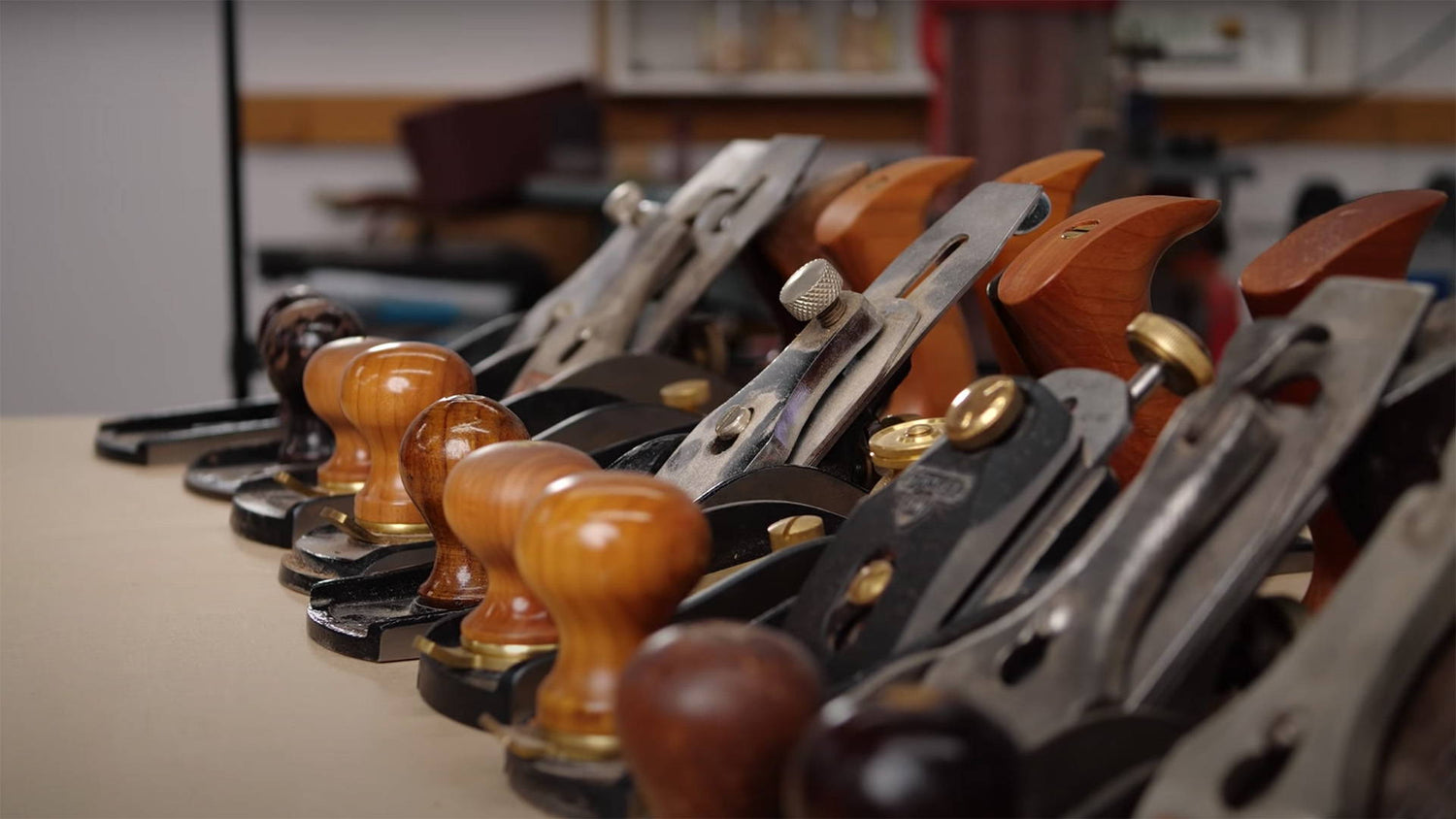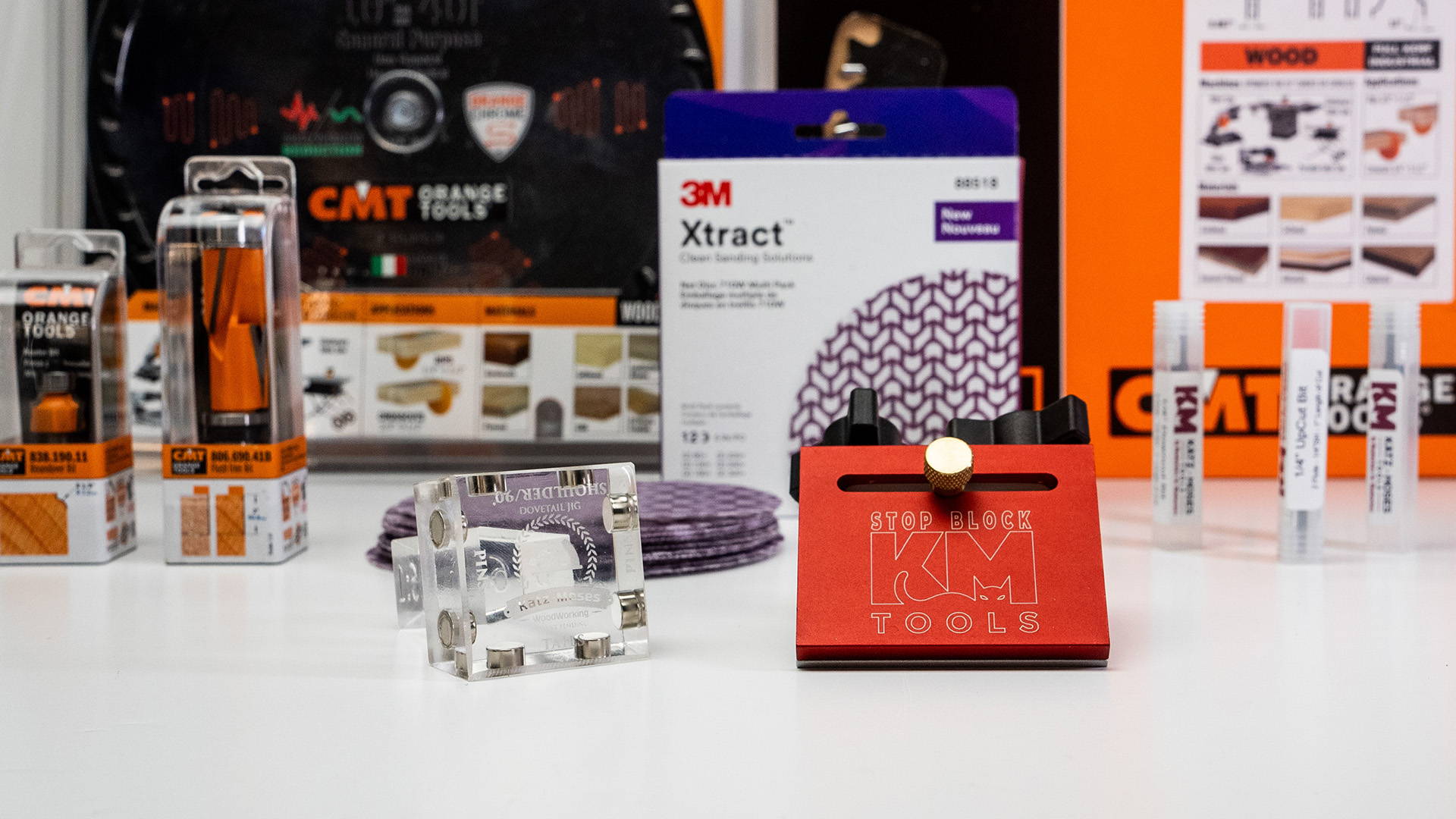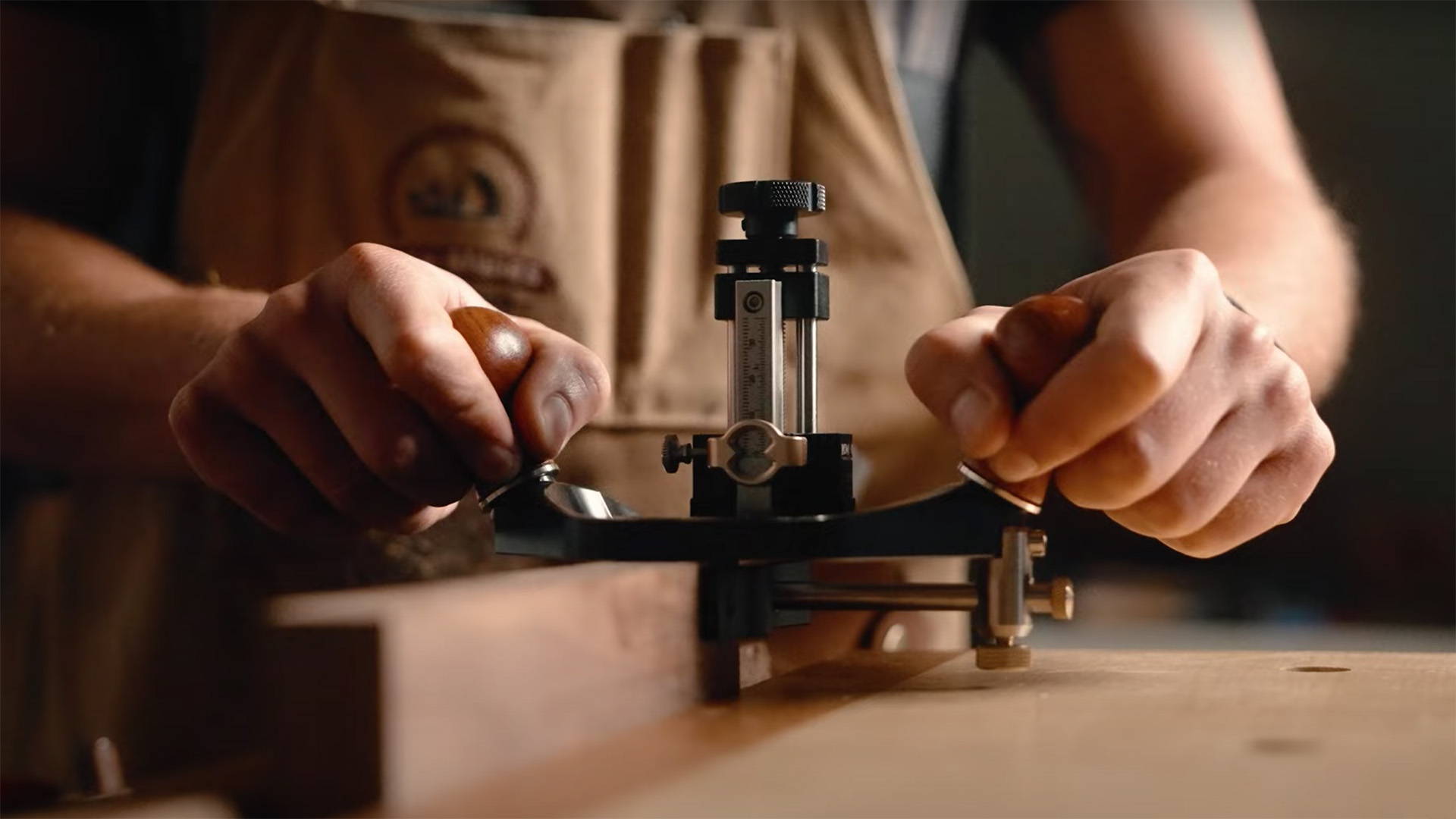If you’re not using hand planes, you’re missing out on one of the most satisfying and useful woodworking tools.
They help with everything from quick clean ups to final smoothing.
And the feeling of taking off tissue-thin shavings? It can’t be beat.
But if you’re mostly a power tool woodworker, it can be hard to know which hand planes you actually need.
Are 30 different hand planes stacked on your shop wall mandatory? Or is there one plane that can do it all?
Today, I’m telling you the first 3 hand planes I recommend for hybrid woodworkers — meaning those of us who use both power and hand tools.
In short, they are:
- Low angle block plane
- Low angle jack plane
- #4 smoothing plane
These three styles will pretty much cover all your hand plane needs. And I’ve also included a few honorable mention specialty planes at the end.
So let’s delve into why I recommend these planes — and whether or not they’re the right choice for you.
DISCLAIMER 1:
In this post, I'm only talking about Western style hand planes. I don't make recommendations on Japanese style planes simply because I do not have enough experience with them to offer much insight.
Japanese style hand planes can produce absolutely masterful results — but you'll have to look elsewhere for recommendations on them (at least for now).
DISCLAIMER 2:
Nothing stirs up woodworking controversy like hand tool advice (alas, the trolls must feed).
My suggestions here are based on my own experience. If you have a different opinion — share it in the comments! But let’s save the snarkiness for Thanksgiving dinner.
FIRST, CONSIDER YOUR NEEDS
Blanket tool recommendations are tricky. The best tool depends on the type of work you do.
If you’re planning on becoming an all hand tool woodworker, you’ll need more than what’s featured in this list (though it’s a good place to start).
But if you only need a hand plane for a few specific tasks, one might be enough.
Take the time to consider exactly what you want to achieve with a hand plane before making a purchase.
As always, I recommend buying tools as they’re needed — not to build a collection of what you think you need (if only I listened to my own advice).
SHOULD YOU BUY NEW OR USED HAND PLANES?
Should you buy a brand new hand plane or scour the nether-nets for a vintage relic?
I’ve done both — and restoring an old hand tool can be a fun process in itself.
That said, I now lean towards buying new hand planes. Especially if it’s your first one.
With a new, good quality plane from a reputable maker, you know what you're getting.
The sole (bottom of the plane) will be flat, the frog or bed will be sturdy, and all the adjustments will work as they should.
Second-hand planes often require more fine tuning and adjusting to get them functioning properly. If you want to start using your plane right out of the box, new is the way to go.
Yes, new hand planes can be surprisingly expensive. But consider it an investment in a super high quality tool that can last lifetimes if cared for.
The “buy once, cry once” principle definitely applies here.
Now, let’s get to my recommendations for your first three hand planes.
LOW ANGLE BLOCK PLANE
My low angle block plane is hands down my most used hand plane.
And it’s the first hand plane I recommend for hybrid woodworkers.
They’re compact, easy to set up, have a ton of uses, and are pretty affordable compared to bigger planes.
Low angle versions typically come with a 12° bed angle and are used with the blade bevel up — making them great for end grain work.
I keep the blade super sharp and set it up for really shallow passes (here’s more about setting up a block plane).
It’s truly my “use it and abuse it” plane.
USES FOR LOW ANGLE BLOCK PLANES
- END GRAIN WORK: The low angle of attack makes them great for trimming end grain, which is useful for taking down proud dovetails, through tenons, dowels, and box joints.
- FLUSH TRIMMING: Excellent for shaving small butterfly keys, plugs, and dowels flush with the rest of your workpiece.
- SMALL CHAMFERS: There’s no quicker tool for breaking the edge of a board. A few passes give you a subtle chamfer faster than you can set up an electric router.
- FIXING IMPERFECTIONS: Accidentally gouge a section of your workpiece? Take it down with a block plane until it’s gone.
- DRIED GLUE SQUEEZE OUT: Dried squeeze out is a pain to remove, but a block plane makes quick work of it. Just know, this falls under the “abuse” category and will definitely require a post-clean up sharpening.
WHAT TO LOOK FOR IN A BLOCK PLANE
First off, I’d go for a low angle over a standard angle block plane.
Lower angles of attack tend to perform better on end grain (which is a big use case for these planes), and the blades can always be honed to steeper angles if need be.
Here’s a few features I’d look for in a new low angle block plane:
- ADJUSTABLE MOUTH: This lets you adjust the opening for chips to pass through and helps prevent tearout. Keep it narrow for shallow cuts and more open for deeper cuts.
- LATERAL ADJUST: In older block planes, you laterally adjust the blade by tapping the sides with a mallet. It can be done, but is pretty finicky. The lateral adjust mechanism on newer block planes makes squaring the plane iron to the sole easy.
LOW ANGLE JACK PLANE
Another low angle plane?! Yes indeed.
Low angle jack planes are incredible all around tools. If I were stuck on a desert island and could only choose one plane, it would be one of these bad puppies.
They might be the most versatile plane out there — making them ideal for woodworkers who aren’t looking to invest thousands of dollars in their hand tool collection.
Like low angle block planes, they have a bed angle of 12° and are used bevel up.
So why am I recommending another bevel-up plane?
Lower cutting angles of attack are generally easier to push through wood and work better on end grain, while higher angles are better for avoiding tearout in figured grain.
With a bevel up plane, you can increase the angle of attack by honing a steeper micro-bevel on the blade for figured wood. You can even have a second iron just for high angle work.
With a standard bench plane, you can increase the cutting angle by putting a back bevel on the iron or with a high angle frog (kind of a pain). But there’s no way to adjust for lower cutting angles.
Because of that, bevel-up planes are more versatile — and can be used for almost all situations as long as the iron is honed to the right angle.
USES FOR LOW ANGLE JACK PLANES
- SHOOTING BOARDS: With a lower cutting angle ideal for end grain and more weight than a block plane, low angle jack planes are perfect for shooting boards.
- END GRAIN WORK: Make a lot of end grain cutting boards? Use a low angle jack plane to initially smooth the surface before sanding.
- INITIAL FLATTENING AND SMOOTHING: Flattening, edge jointing, smoothing — all can be achieved with a low angle jack plane. You might not get as smooth results as with a standard angle bench plane, but a steeper micro-bevel can get you dang close.
- HIGHLY FIGURED WOOD: If you have a board with haphazard grain direction, put a steep 40° micro-bevel on the blade. Combined with the bed angle, you now have a 52° angle of attack — which is well suited to avoiding tearout in figured wood.
#4 SMOOTHING PLANE
A smoothing plane is probably the last hand plane you need as a hybrid woodworker. But it’s an absolute pleasure to have.
They can give you glassy smooth surfaces that need very little sanding — if any at all.
And with shallow enough of a cutting depth and an extra sharp blade, they can even be used for end grain work.
The reason I’d go with a low angle jack plane first is because it can do pretty much anything a smoothing plane can — though maybe not as well in terms of smoothing and jointing.
But if you’re using power tools and sanding anyway, the difference is negligible.
In terms of size, I recommend a #4 smoothing plane. It’s hefty enough to give help when pushing through cuts, but not so heavy you get worn out after just a few passes.
BEST USES FOR SMOOTHING PLANES
- SMOOTHING: As the name implies, these planes can produce beautifully smooth surfaces. Use them to cut down on sanding time or avoid sanding all together.
- EDGE JOINTING: It’ll take a little more eyeballing and fine tuning than a dedicated jointer plane, but a #4 is great for roughly jointing an edge before taking it to the power jointer or table saw.
- FIGURED WOOD: The typical 45° angle of attack on these planes works well for figured wood. But if you need a higher angle, you’ll either need to add a back bevel or install a high angle frog.
HONORABLE MENTIONS: RABBETING, SHOULDER, AND ROUTER PLANES
Rabbeting, shoulder, and router planes are specialty planes designed to help fine tune joinery in hard to reach places.
The big difference in their functionality from regular planes is the cutting edge isn’t limited by the mouth opening.
This allows you to trim down material right up against the edge of a lap joint, groove, or tenon.
They all work well for the job — and I have a rabbeting block plane I adore.
But if I had to choose only one, I’d go with a router plane.
Router planes are the most versatile specialty plane. And they have the added advantage of cutting coplanar to your reference face.
That means you can cut tenons and half laps perfectly parallel to the rest of the board.
Sure, I may be partial since we recently released our own signature router plane. But it really is an incredible tool for fine tuning joinery — and is capable of so much.
Wondering about all the uses for a router plane? Check them out here.
ENOUGH EXPLAINING, GET PLANING
Even though they’re low tech tools, hand planes can do a ton for your woodworking. And they’re too much fun to use.
The types of planes listed above will provide the average power tool woodworker with everything you could ask for from a hand plane.
Just remember: The best tool is the tool that works best for you.
So get yourself a plane, get in the shop, and start making those shavings.
Have your own hand plane recommendations? Share them in the comments below!
Follow us on Instagram @katzmosestools, on TikTok @katzmoseswoodworking, and check out my YouTube channel for more great woodworking content...
And as always, STAY SAFE IN THE SHOP!











6 comments
Mark
Nice info. You state you don’t know anything about Japanese hand planes, yet that’s all you offer in your shop. You have no “traditional” planes for sale. What’s up with that?
Nice info. You state you don’t know anything about Japanese hand planes, yet that’s all you offer in your shop. You have no “traditional” planes for sale. What’s up with that?
Larry
So how would a novice plane user know the difference between plane styles?There are about as many planes as saw blades. Thanks
So how would a novice plane user know the difference between plane styles?There are about as many planes as saw blades. Thanks
Anonymous
What manufacturer do you recommend for these 3 planes? Thai helps so much for m me. I primarily use power tools but have always wondered which hand planes I’d need.
What manufacturer do you recommend for these 3 planes? Thai helps so much for m me. I primarily use power tools but have always wondered which hand planes I’d need.
Anonymous
When are the router plains going to ship out. Seems like I’ve been waiting a long time. Please let me know. Thanks, Jim C.
When are the router plains going to ship out. Seems like I’ve been waiting a long time. Please let me know. Thanks, Jim C.
Chris
Great summary, Jonathan – exactly what I would have said, FWIW.
Great summary, Jonathan – exactly what I would have said, FWIW.
Anonymous
For a shooting board I prefer a 5 1/2.
The bigger size of this plane helps glide through end grain and is easier to hold.
I greatly appreciate your weekly blogs and YouTube productions.
For a shooting board I prefer a 5 1/2.
The bigger size of this plane helps glide through end grain and is easier to hold.
I greatly appreciate your weekly blogs and YouTube productions.